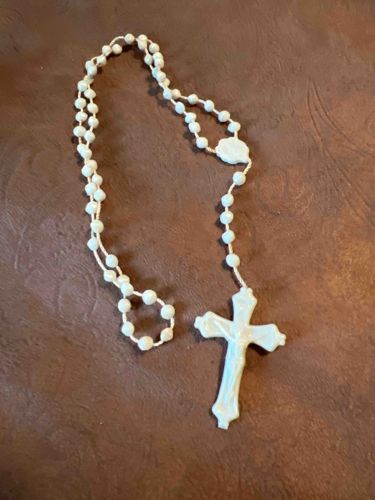
White Plastic Rosary Beads
This item is a traditional Catholic rosary, constructed primarily from white or off-white plastic components. The rosary features numerous small, ovular beads forming the main prayer loop and a shorter segment leading to a crucifix. The beads appear to be uniform in size and shape, strung together on a thin, white cord or string, which is visible between each bead. The overall color is a consistent light, creamy white, suggesting it may be made from a plastic such as celluloid, bakelite, or a similar synthetic polymer, common in rosaries from the mid-20th century onwards due to its durability and affordability. A key feature of the rosary is the central connector, which is also made of the same white plastic and appears to depict a religious figure or symbol, though the details are somewhat indistinct due to the material and resolution. Connected to this central piece is the shorter strand of beads culminating in a crucifix. The crucifix is substantial in size relative to the beads and is rendered in the same white plastic. It features a molded corpus (the body of Christ) clearly visible on the cross, indicating a devotional piece. The surface of the plastic elements appears relatively smooth, with a subtle sheen. Regarding condition, the rosary exhibits some signs of wear consistent with age and use. There are slight discolorations or darkened areas, particularly around the stringing holes or in the crevices of the crucifix, which could be accumulated dirt or natural aging of the plastic. No significant cracks, chips, or breaks are immediately apparent, suggesting good structural integrity. The craftsmanship appears to be a standard manufacturing process, typical of mass-produced religious articles, rather than hand-carved or artisanal work. The style suggests it could date from the mid-20th century to more contemporary times, given the common use of plastic for such items during this period. The simplicity of design indicates a functional devotional item rather than a high-value collectible, though its sentimental or religious significance may be considerable.
AI-Generated Appraisal Disclaimer
Estimated Value
$5 - $15
Basic Information
Category
Religious Devotional Item
Appraised On
November 30, 2025
Estimated Value
$5 - $15
Item Description
This item is a traditional Catholic rosary, constructed primarily from white or off-white plastic components. The rosary features numerous small, ovular beads forming the main prayer loop and a shorter segment leading to a crucifix. The beads appear to be uniform in size and shape, strung together on a thin, white cord or string, which is visible between each bead. The overall color is a consistent light, creamy white, suggesting it may be made from a plastic such as celluloid, bakelite, or a similar synthetic polymer, common in rosaries from the mid-20th century onwards due to its durability and affordability. A key feature of the rosary is the central connector, which is also made of the same white plastic and appears to depict a religious figure or symbol, though the details are somewhat indistinct due to the material and resolution. Connected to this central piece is the shorter strand of beads culminating in a crucifix. The crucifix is substantial in size relative to the beads and is rendered in the same white plastic. It features a molded corpus (the body of Christ) clearly visible on the cross, indicating a devotional piece. The surface of the plastic elements appears relatively smooth, with a subtle sheen. Regarding condition, the rosary exhibits some signs of wear consistent with age and use. There are slight discolorations or darkened areas, particularly around the stringing holes or in the crevices of the crucifix, which could be accumulated dirt or natural aging of the plastic. No significant cracks, chips, or breaks are immediately apparent, suggesting good structural integrity. The craftsmanship appears to be a standard manufacturing process, typical of mass-produced religious articles, rather than hand-carved or artisanal work. The style suggests it could date from the mid-20th century to more contemporary times, given the common use of plastic for such items during this period. The simplicity of design indicates a functional devotional item rather than a high-value collectible, though its sentimental or religious significance may be considerable.
Related Tags
Get Your Items Appraised
Instant estimates of your treasures with AI-powered instant appraisals